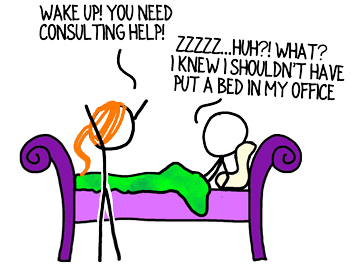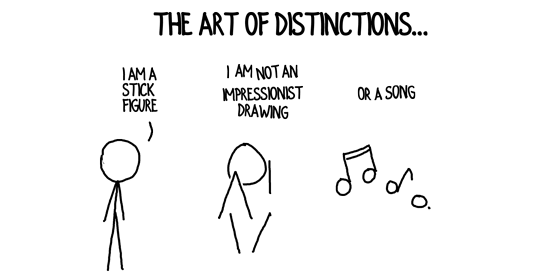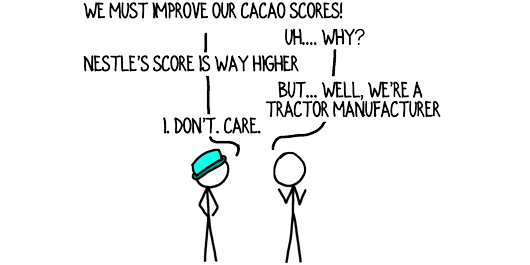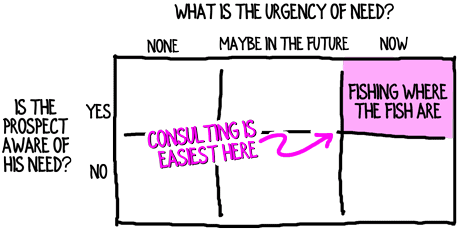Phil Erful, CEO of Zeppelinnovation needs your consulting firm’s expertise. His company’s results have bobbed along uncertainly; however, with your advice, Zeppelinnovation’s fortunes would rise steadily. There’s only one problem:
Phil doesn’t realize he’s tethered to a poor approach and that your consulting firm could release the restraints on success.
Drats! Your target market is filled to bursting with prospects who need your consulting firm’s help… if only they would wake up and see it.

Unfortunately, no amount of yelling, gesticulating or launching fireworks will convince clueless sufferers to contact your consulting firm for assistance.
What will?
How do you attract Phil, who has the cash to hire your consulting firm, has the need for your services and is only lacking awareness?
Diagnostics.
A well-crafted diagnostic pinpoints your prospect’s current state and highlights the optimal next step. And their optimal next step is to work with your consulting firm!
It’s fairly straightforward to develop a powerful diagnostic that will inflate your consulting firm’s client portfolio. You merely need to tackle the three, underlying elements of every diagnostic:
Diagnostic =
Distinctions and Implications, Communicated Simply
If you were an aeronaut, you might use an altimeter as a diagnostic tool. It shows your elevation on an easy-to-read scale (feet). If your altimeter displays 2000, you can enjoy the view. If it reads 20,000, you better call for rescue. It you see -287, you landed in Death Valley… oops, climb out and feign ignorance.
Step 1. Brainstorm Distinctions
Distinctions are a way of saying, “You are here, not there.” Or, “The world is this way, not that way.”
For instance, we often need to point out the difference between a founder/owner mindset and an employee mindset for consulting firm leaders to understand why the “emulate me” approach to training typically fails.

The following questions will help you generate a list of distinctions:
- What separates clients who soar from those who don’t?
- What do your high-flying clients know that run-of-the mill clients don’t?
- How are the clients who will succeed in five years different from clients who are succeeding today?
- What steps did some clients take to overcome an issue?
- What’s the #1 indicator that a prospect has a problem you can solve?
Step 2. Assign Implications to Important Distinctions
Look at your list from Step 1. Which distinctions are most likely to make Phil exclaim, “Aha!” and give him the direction he desperately needs?
The most important distinctions are those your consulting firm’s prospects haven’t considered in advance but are blazingly obvious in hindsight.
Every result from your diagnostic should have an associated step forward. If the altimeter says you’re too low, fire the burner. If it says you’re much too high, you may need to open the parachute vent.
Step 3. Develop a Simple Communication Framework
You can always fall back on the classic, 2×2 matrix to convey your distinctions. They’re easy to draw and explainable in about 15 seconds. But there are plenty of other possibilities.
For example, the oft-used Myers Briggs assessment assigns four letters that are surprisingly straightforward to understand. (Whether they’re right or not is a separate conversation.)

Once your consulting firm has a proven, effective diagnostic, expand its effectiveness by making it:
Self-Administered with Benchmarks
Phil may treat your consulting firm’s assessment of Zeppelinnovation as blowing smoke, particularly if your diagnosis was unsolicited.
Phil is much more likely to believe the findings, when he self-appraises his company’s position using your consulting firm’s framework.
Even so, he may have no urgency to rectify his situation. That’s where benchmarks, which attach emotionally-laden meaning to specific points on your diagnostic scale, work magic.

Employ competition, internal goals or other standards to create effective benchmarks.
When your diagnostic reveals Zeppelinnovation has risen only halfway to the mark competitive businesses have achieved, suddenly Phil’s deflated and realizes he needs your consulting firm’s guidance.
Share your experience with diagnostics—either ones you’ve encountered or diagnostics your consulting firm administers.
Text and images are © 2024 David A. Fields, all rights reserved.

 David A. Fields Consulting Group
David A. Fields Consulting Group 



I’ve tried but as of now, haven’t had success in landing a client/project although the thank you notes were nice to receive. I think these are ways to (a) open doors for future needs and (b) opportunities to expand the network as the future client may refer you to one of their connections. Doesn’t hurt to try!
On a related note, I appreciate the chocolate/peanut butter reference (as I handed many out last night!) but I caution the use of using references and tools that are not valid or reliable. It might put you in a place where future client wants the idea referenced included in your creative solution. Imagine having to create alternative options to meet all the different learning styles…… Happy Halloween and other myths! 🙂
Thank you for adding your experience, Bill. It sounds like your diagnostic may need some tweaking. Or, perhaps, it’s confirming that you’re not targeting an urgent, expensive need. That would be good learning too, and would allow you to shift your firm’s focus slightly.
Re incorporating tools and references that are unreliable, it probably depends on the context and intention. For instance, if you’re using the reference simply to facilitate communication (“They’re as different as a jack-o-lantern is from the Easter bunny”) it may not matter if your references are unreliable or even fictional. On the other hand, you’re absolutely right that it would be a massive error to incorporate an unreliable or invalid tool into your own diagnostic.
I appreciate your smart insights, Bill!
Great post! Our challenge has been getting clients to actually complete the diagnostic survey. They say they want them, but it’s seldom top on the priority list to do. It may be that having a forcing event like a coming workshop could unstick things. I’d love other ideas!
You’re right, Steve, the stubbornly information-averse are poor prospects.
Imagine the physician who frets that half of people with diabetes don’t know they suffer from the condition. It’s easily diagnosed with a blood test; however, many people don’t bother to get a blood test even when they’re told such a test could reveal important medical conditions.
If at all possible, make your diagnostic more engaging (perhaps even entertaining) than a survey. Also, we’ve found that the promise of benchmarks at the end will increase participation in a diagnostic.
Thank you for jumping into the discussion, Steve!
Hi David,
How do you get your diagnostic into the hands of prospects, without them thinking it’s just another sales tool? Do you send it to them before or after you’ve had a conversation with them?
Good questions. I’m interested in the same issue.
Excellent question, Praveen. There are many ways to do that. You can administer it inside the context of other marketing, such as a speech, webinar or podcast; you can offer it separately within other marketing; you can invite people to self-administer the diagnostic during your other marketing; you can distribute or administer your diagnostic as part of smaller, or preliminary engagements.
Those are a few ideas. Thanks for posing the challenge, Praveen!
Thanks David for this article. An assessment/ diagnostic tool is a great way for an owner/ operator to evaluate where the business is currently. I have a list of questions with scoring. What are some ways to create an electronic tool wherein the person fills in a Yes/No answer to a list of questions and based on the backend scoring rubric (already fed by me) they would receive an electronic report? I welcome your suggestions on a tool that does not require any software programming on my part. Thanks!
BJ, there are a ton of tools you can leverage, from simple Google forms to dedicated survey devices and apps. Or, you can have a custom-built application created quite inexpensively these days by resources on Upwork, Fiverr or elsewhere. (Other readers may have specific suggestions.) We’ve had some of our diagnostics custom-built for us into web-based applications, and they work great like that.
Thanks for the follow-on question, BJ!
Thanks David for your suggestions. Appreciate it!
Of course, BJ. Let me know how it goes!
Stopped reading after “an even better solution”… 💚 okay I didn’t really, but could have. It is such a good reminder that I make thing more difficult than they need to be and it is way easier to be successful fishing where the fish are.
I’ve had good success with a diagnostic we have developed in two ways; one was using it as a CTA/lead gen piece to help create clarity on where people are and second as a core piece of our offering. In both cases we’ve generated new business. The main challenge with diagnostics is that they inherently don’t have value and aren’t necessarily a cause of the result you want unless you act on the info (even if acting means not changing).
Totally agree on all your points, Christopher. Fishing Where the Fish Are is way easier than trying to lure fish to your firm. And diagnostics can be a difficult sell because all the client gets at the end is an indication of where they need to spend money. We no longer offer standalone, paid diagnostics partly for that reason.
Good on you for having success with diagnostics as a CTA and as part of your offering. Well done! (Also, thank you for sharing your case study, Christopher.)